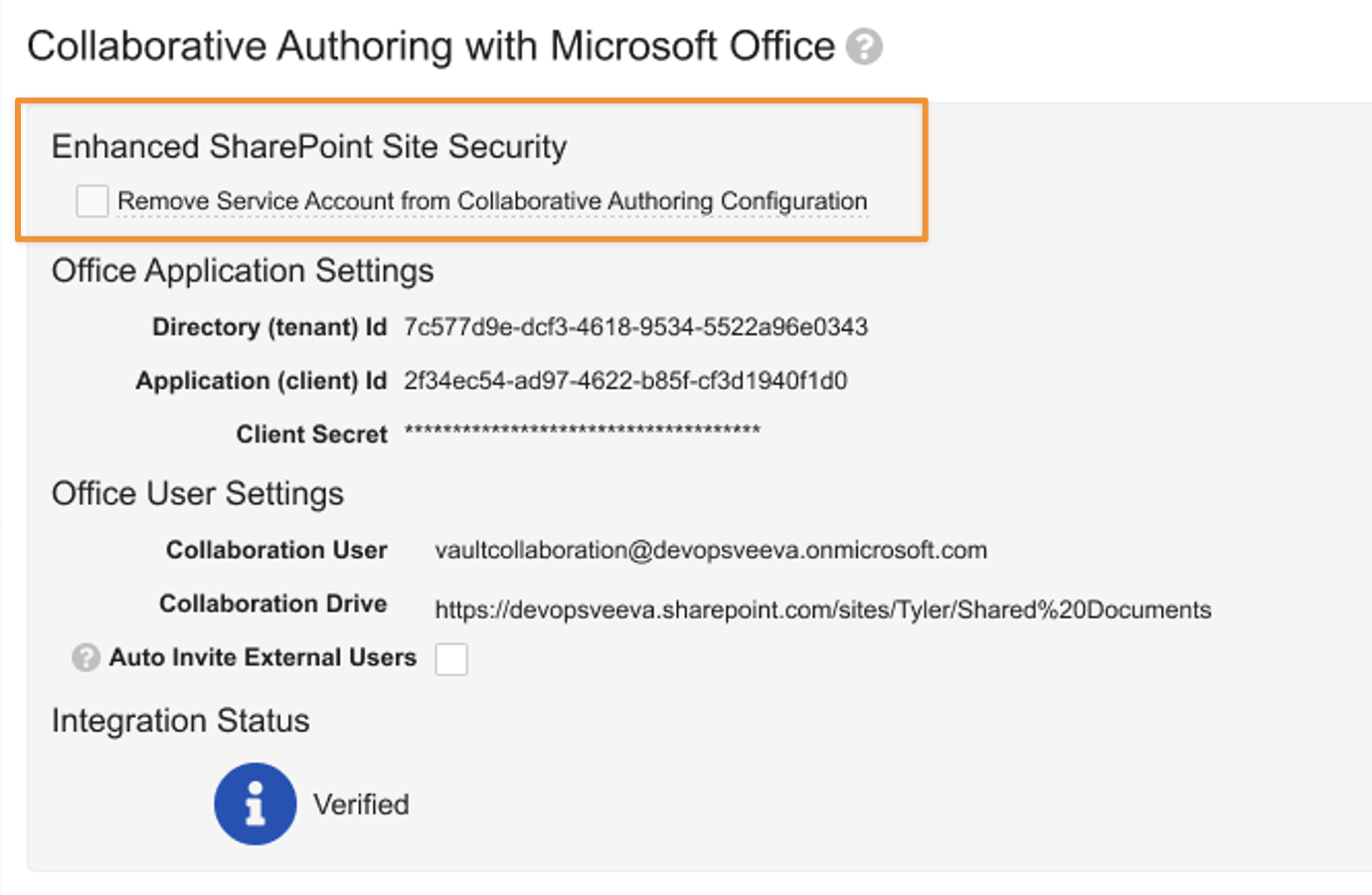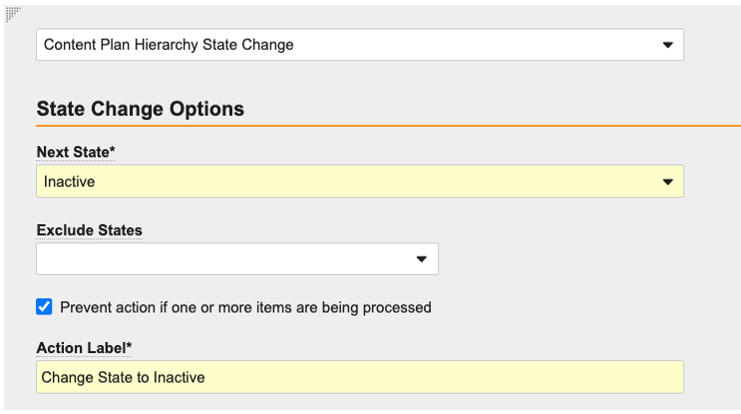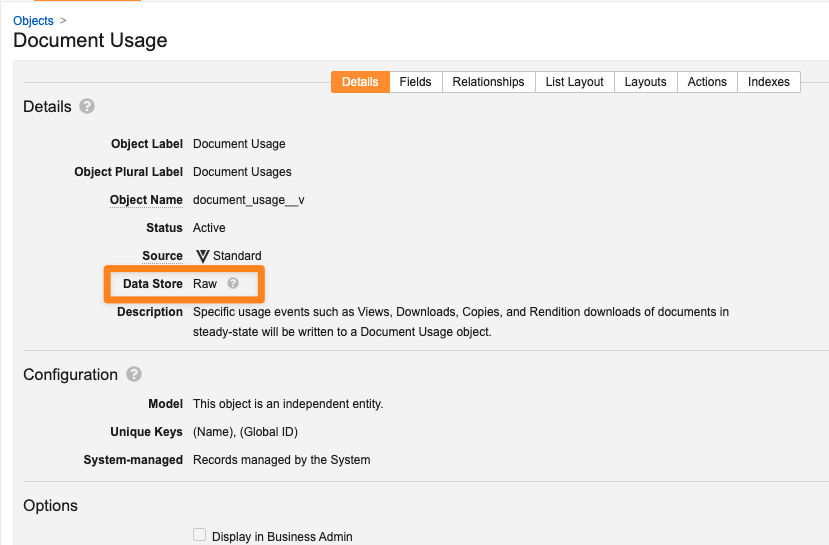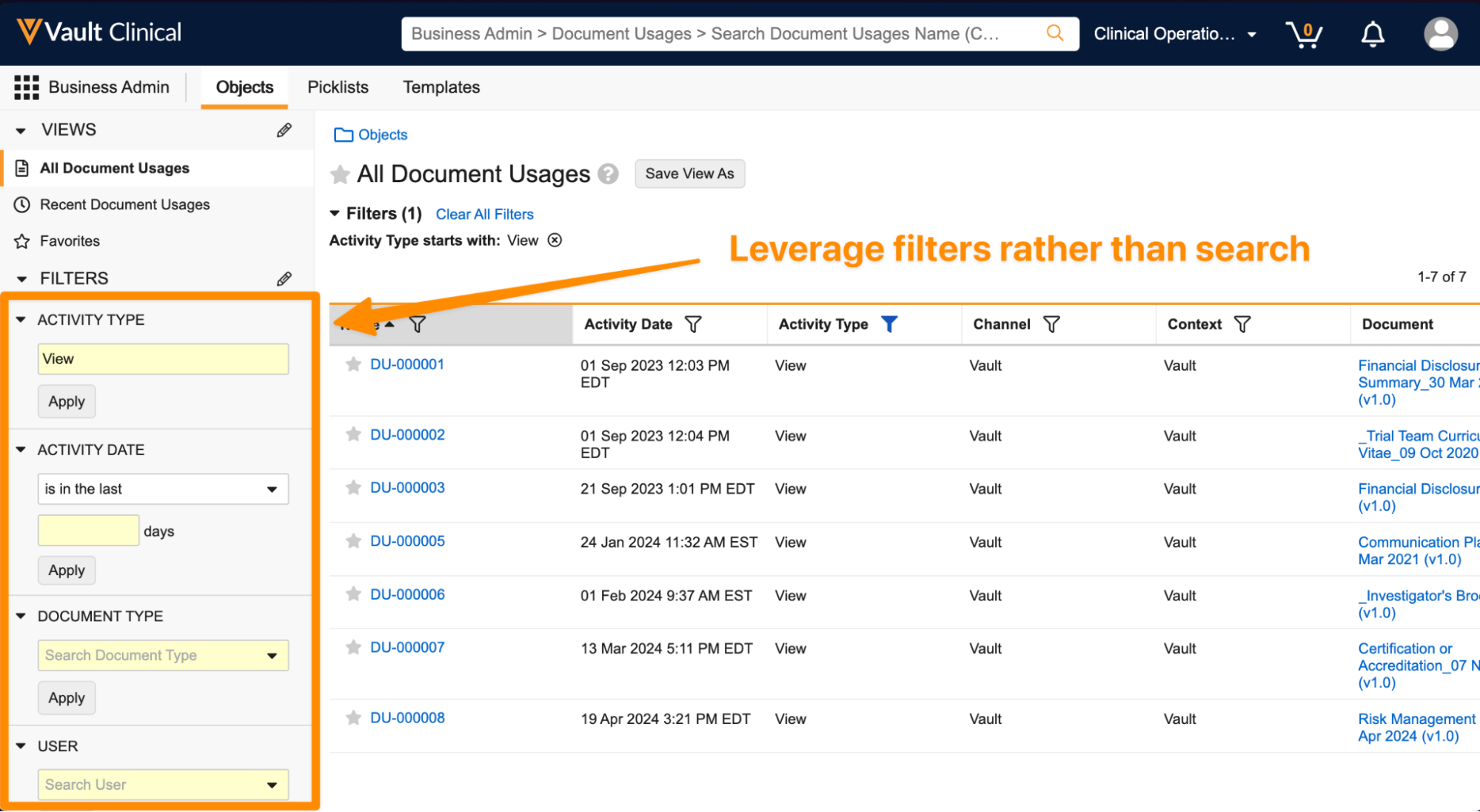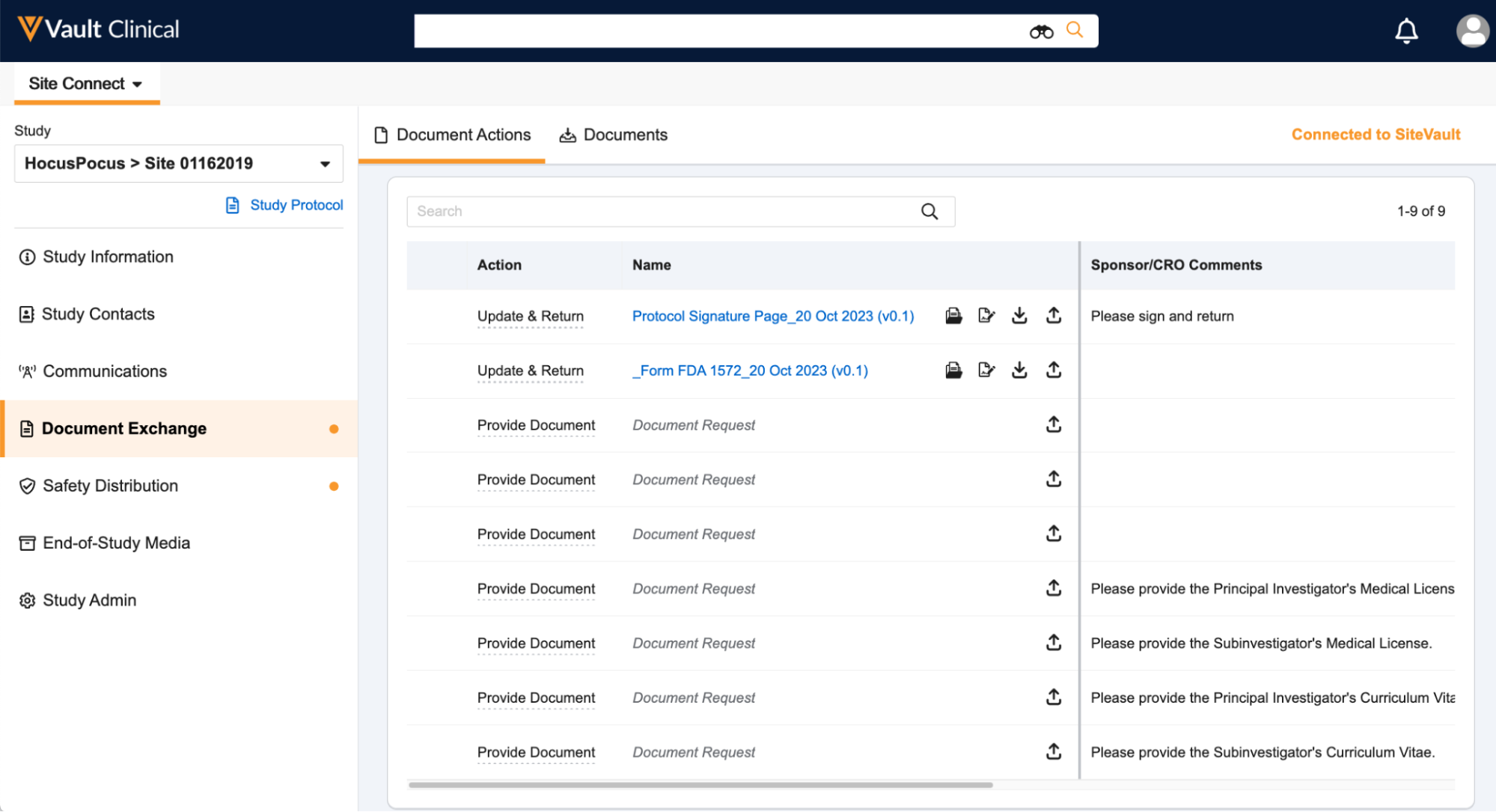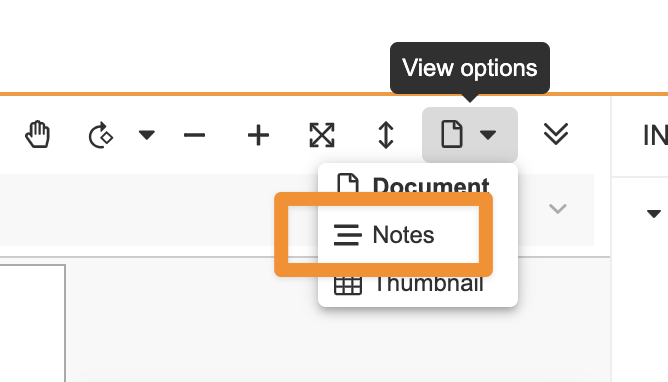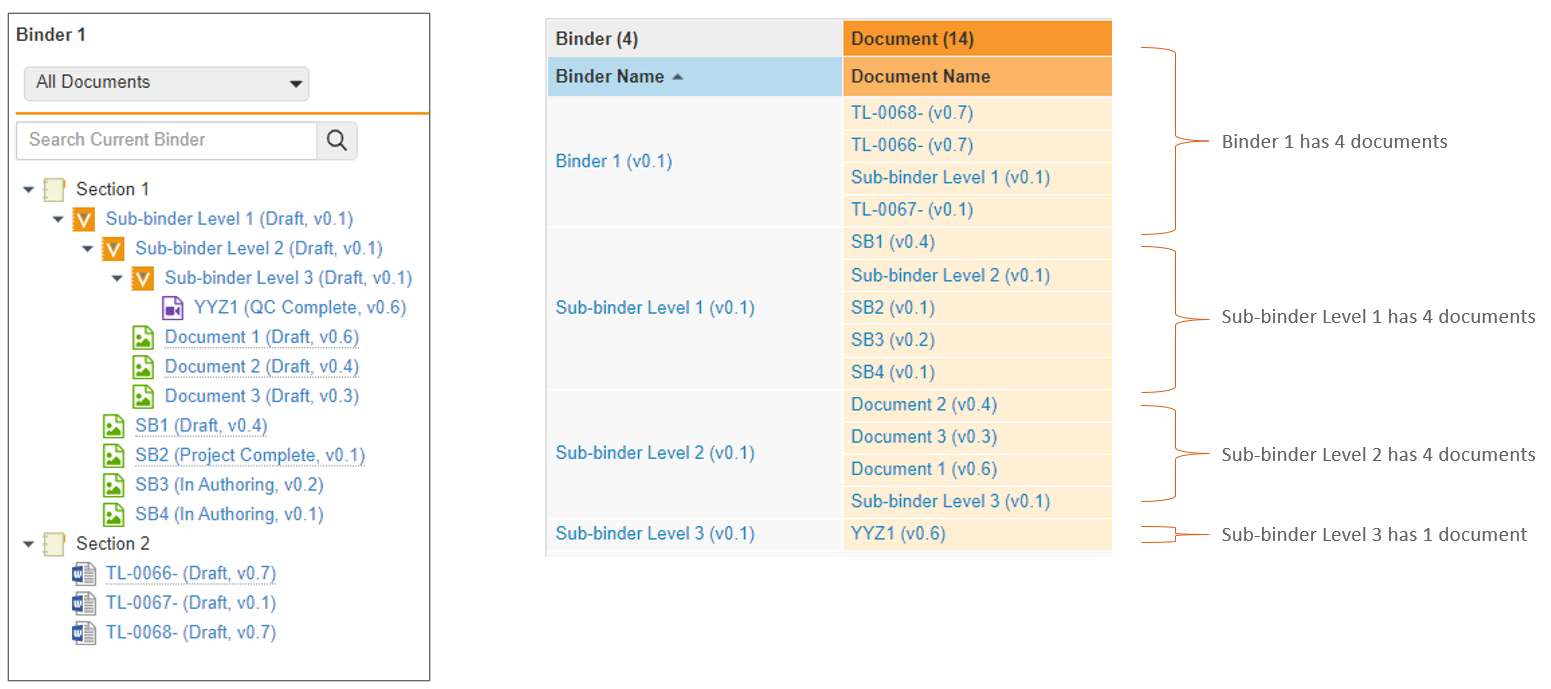25R2
Upcoming Changes to Scheduled Data Exports
In 26R3, the Veeva Vault platform Scheduled Data Exports functionality will be disabled in favor of more robust and scalable alternatives, Direct Data API and Vault Loader APIs. To prepare for deprecating this functionality, planned limitations will be put in place over the next few general releases.
In 25R3, if you modify your Scheduled Data Export configurations, the system will enforce a strict limit of 30 entities.
In 26R3, the Scheduled Data Export functionality will be removed. Prior to this release, customers should begin exploring alternative implementations using the Vault Loader APIs or Direct Data API.
Changes to Using Migration Mode When Auditing Is Disabled in 25R3
Starting in 25R3, if the Audit data changes in this object checkbox is cleared, creating or updating records in Record Migration Mode will no longer generate an audit.
Currently, when records are created or updated in Record Migration Mode, Vault generates an audit entry even if audit is disabled for that object. In the 25R3 release, Vault no longer generates audit entries for objects with auditing explicitly turned off, even when Record Migration Mode is in use. This change is being made to prevent the creation of unwanted audit data.
Related Object Record Limits Introduced in 25R2
In 25R2, the Veeva Vault platform is introducing a limit on the total number of join records retrieved for simple join relationships when a user views a record detail page’s related object section. This limit enhances performance and ensures reliable loading of records.
Prior to 25R2, all related records were retrieved and the full count displayed, which could lead to extended load times or timeouts for record detail pages with a large number of records in a simple join relationship.
With the 25R2 release, Vault will retrieve a maximum of 10,000 records for simple join relationships. This means that subsequent searches, sorts, and filters (Criteria VQL) within the related object section will apply only to these first 10,000 retrieved records. The retrieval order for these records will be based on their created date. We are implementing this change to prevent extended load times and timeouts for pages with millions of join records.
Checklist Fields Inactivated and Duplicate Available Answer Records Deleted in 25R3
With the Available Answer and Comment checklist enhancements for Vault Platform released in 25R2, the below fields are no longer used by checklists but will remain Active to preserve existing Vault configurations and customer integrations. These fields will be set to Inactive in 25R3.
- The Translation Versions field on the {Target Object} Checklist object
- The Answer field on the {Target Object} Dependency object
- The Comment field on the {Target Object} Response object
- The following fields on the {Target Object} Available Answer object:
- Response
- Hash Code
- Selected
- Order
Duplicate {Target Object} Available Answer records will also be deleted in 25R3.
Template Requirement Refactoring Enforced in 25R3
Starting with the 25R3 release, the Template Requirement Refactoring feature for Veeva Validation Management will be enforced across all Vaults.
Customers currently using the legacy Template Requirement feature with the Template Requirement (val_template_requirement_v) object must update their configurations to use the Validation Requirement (val_requirement_svo__v) object instead. Prior to 25R3, we recommend that customers enable the following settings for their Vaults in Admin > Settings > Application Settings > Validation:
- Refactor Template Requirement
- Migration Template Requirement
With the 25R3 release, these settings are automatically enabled and removed from Admin > Settings > Application Settings > Validation. The new refactored logic will then be fully applied and required for all customers. Ensure that your configurations are updated before the 25R3 release to avoid disruption.
Learn more about Managing Templates (Validation Management).
Station Manager: Updated Minimum Supported Version of Android OS in 26R1
The minimum supported version of Android for Veeva Station Manager will be updated to Android 14 in 26R1. Upgrade the OS of your current Station Manager devices that are running OS versions below Android 14 to Android 14 or higher prior to the 26R1 release. After the 26R1 release, Station Manager operators using Station Manager devices running Android OS versions below Android 14 will no longer be able to log in to the Station Manager app.
TRIA for All Training Requirements Automatic Enablement in 26R1
The Enable TRIA for all Training Requirements Application Setting will be automatically enabled in all Veeva Training and Veeva Study Training Vaults in 26R1, when TRIA will be enhanced further to determine when a given Training Requirement is ready for training.
This previously-optional setting was released in (22R1) to support triggering the TRIA process for Vault Document Training Requirements with a single document and no quiz, or simple requirements. In parallel, the setting was enabled in all Vaults created on or after the 22R1 release.
Since then, we’ve released several enhancements to the Training Requirement Impact Assessment feature set which require the setting to be enabled:
- Reconcile Retraining with TRIA Decisions (25R1)
- Automated Generation of Training Requirement Impact Assessment (TRIA) & Display in Document Change Control (DCC) (25R2)
- Automatic Completion Credit for Document Participants (25R2)
- Delta Training (25R2)
These and other features have also introduced several Training Requirement Impact Assessment object fields which can be configured to skip the TRIA task and expedite closing the TRIA record in certain situations. Customers who have not yet enabled the setting should consider these configurations to accommodate automatically closing unneeded TRIA records.
25R1
Selected Entity Limit for Scheduled Data Exports
In 26R3, the Veeva Vault platform Scheduled Data Exports functionality will be disabled in favor of our more robust and scalable alternatives, Direct Data API and Vault Loader APIs. As we prepare to deprecate this functionality, planned limitations will be put in place over the next few general releases.
In 25R1, the maximum number of entities that can be included in Scheduled Data Exports is now limited to 30. This limit will not be enforced for Vaults that are already over this limit.
In 25R3, if you modify your Scheduled Data Export configurations, the system will enforce a strict limit of 30 entities.
Finally, in 26R3, the Scheduled Data Export functionality will be removed. Prior to this release, customers should begin exploring alternative implementations using the Vault Loader APIs or Direct Data API.
List Layout Now Respects Name Field Position
In 25R1, the Veeva Vault platform is enhanced so that the first column in record pickers, related object sections, and list views can display a field other than the Name field. The UI now recognizes the configured Name column position. Prior to this release, even if the Name field was not configured in the top position, Vault would always show Name as the first column. With this release, Vault will show the Name field wherever it is configured to show in the object’s List Layout configuration.
In instances where Name is not currently configured as the first field, users may notice that Name is no longer displayed in the first column in record picker dialogs.
Creation of New Adobe Formatted Outputs Not Allowed in 25R2
The 25R1 release includes the Word Formatted Outputs feature for the Veeva Vault platform, which allows Admins to use a Microsoft Word file as the template file for a formatted output instead of an Adobe XFA file. With 25R1, Admins can continue to create new Adobe formatted outputs in Vault. However, with the 25R2 release, all new formatted output configurations must use Word formatted outputs instead. Existing Adobe formatted outputs will remain unaffected and can still be used and edited in a Vault.
Enhanced Configuration of Collaborative Authoring
Configuring Collaborative Authoring in the Veeva Vault platform no longer requires a Service Account (Collaboration user) to connect Vault and SharePoint. When Collaborative Authoring was introduced, SharePoint did not support managing the permissions at the application level, which necessitated the use of a Service Account. Now that SharePoint supports this, updating the configuration for Collaborative Authoring helps enhance the security of the integration and brings the configuration in line with typical best practices.
Existing Vaults with Collaborative Authoring will need to update the configuration by the 26R1 release, when support for the Service Account configuration will be fully deprecated.
Updating this configuration is primarily done in Microsoft Entra ID (previously Azure Active Directory). Once the necessary updates are made in Microsoft Entra ID, Admins can disable the Service Account in Admin > Settings > Checkout Settings:
Document Audit Trail Formula Fields Support
With the availability of Cycle Time Functions in the Veeva Vault platform to support Process Reporting functions in document report formula fields, starting in 25R1, new document formula fields can no longer be configured in Admin > Configuration > Document Types.
Any existing configured document formula fields using document status or state type will continue to function in 25R1. Prior to 24R3, these fields also supported other fields, such as picklists; those fields will be supported until 25R2.
After 25R2, if a configured document formula field is not using document status, the field will begin returning blanks.
Detailed Publishing Results for Viewing Broken Links No Longer Displayed
In a future RIM release, when reviewing validation rules for broken links, Submission Validation Results records will no longer display a table of broken link information. Instead, they will provide a link to Link Evaluator.
In anticipation of this upcoming change, we highly recommended that Admins configure Link Evaluator for RIM Submissions Publishing. After the update is released, customers without Link Evaluator configured who attempt to view detailed validation results about links will no longer be able to see link information from the Submission Validation Results record.
Default Behavior of Content Plan Hierarchy State Change
In a future RIM release, the Prevent action if one or more items are being processed checkbox on the Content Plan Hierarchy State Change user action will be defaulted to True (selected) when creating Content Plan Hierarchy State Change user actions.
For example, creating a new Content Plan Hierarchy State Change user action will default the checkbox to True:
Existing user actions for Content Plan Hierarchy State Change are not impacted or changed.
QualityOne HACCP Application Preparation
In 25R2, HACCP will become a separate application in QualityOne. In preparation for the transition of HACCP features to the new HACCP application, Admins of existing QualityOne Vaults may see a new licensing option in 25R1 for HACCP listed in the Application Licensing section of User records in their Vaults. There is no impact to features or functionality and no action is required.
24R3
Validation Results Archival Job Activation in 25R1
In 25R1, the Validation Results Archival job will be set to Active on all RIM Vaults. For RIM Vaults with a Publishing license, this job will run daily to archive any validation results on Submissions with an Actual Submission Date older than 90 days. For non-Publishing RIM Vaults, this job will complete with no action taken.
If the job is already Active on your RIM Vault, no action will be taken. If you want to activate this job before the 25R1 release, navigate to Admin > Operations > Job Definitions and set the Validation Results Archival job status to Active.
Submission Validation Results Moving to Raw Object in 25R1
In 25R1, the Validation Result (submission_validation_result_v) object will move to a Raw object data store. As part of this change, a new Rule Severity (rule_severity__v) picklist and field are added in 24R3 as part of the RIM Publishing Scalability Enhancement feature, replacing the current Severity (severity__v) field. The new Rule Severity field will allow for sorting Validation Result records once converted to the Raw object data store. The move to the Raw object data store will increase the publishing performance for validating published Submissions. Raw objects do not support search functionality on related object sections. This will no longer be displayed on the related object section of Submission records in 25R1.
Viewing and Annotation of Protected PDFs Applied to All Vaults
In 25R2, for documents that contain digital signatures from external solutions (such as AdobeSign or DocuSign), Vault will generate a copy of the document as the viewable rendition, where digital signatures and write protection will not be effective. This already happens in some instances, but there can be variability depending on the source file settings.
The Allow viewing and annotation of protected PDF files setting will be automatically enabled in all Vaults in 25R2 to create a consistent experience. With this change, digital signatures will be consistently invalid on viewable renditions, though the signature details on the source file are not impacted.
Currently, Vault may be unable to render PDFs in certain cases depending upon the specific protection settings of the source PDF, even if the file is not protected from viewing overall. This creates confusion and an inconsistent experience.
By enabling this setting in all Vaults, documents will be rendered and applicable rendering processes (such as Optical Character Recognition and Overlays) will be applied in any scenario where Vault can view the file (such as when the file is not password-protected from viewing). This will ensure these files are consistently rendered and all standard processes are applied to viewable renditions that are not read-protected.
Documents that are write-protected will maintain this protection in the viewable rendition, though the rendition itself will be unable to be unprotected.
Changes to Formatted Outputs in 25R1
The 25R1 release includes the Word Formatted Outputs feature, which allows Admins to use a Microsoft Word file as the template file for a formatted output instead of an Adobe XFA file. With 25R1, Admins can continue to create new Adobe formatted outputs in Vault. With the 25R2 release, all new formatted output configurations must use Word formatted outputs instead. Existing Adobe formatted outputs will remain unaffected and can still be used and edited in a Vault.
Opt-Out Setting for Future Summary Email Enhancements
In 25R1, we are introducing several enhancements to help reduce notification overload for users by using Summary Email notifications as a standard more frequently:
- Setting the Email Preference field to Summary if it was previously set to Every Occurence on many notification templates (for both Platform as well as application-specific templates).
- Updating the Delivery Interval default value to 1 hour.
- Exposing some notification-related fields on the User Profile page by default, including Annotation Replies, Send As Link, Shared Views and Favorite Documents notification fields, and Summary Email Interval, allowing users to adjust their own notification preferences.
- Favorite Documents is a new notification category that will be available in 25R1, allowing users to choose email preferences for Favorite Document notifications.
- Summary Email Interval is a new field that will be available in 25R1 which will allow users to choose the interval that works best for them.
This change will help all users to receive fewer overall emails from Vault, while still receiving the information they need in Summary Emails.
To give customers an option for additional time to prepare for these changes, 24R3 introduces a new checkbox in Admin > Settings > General Settings which allows customers to defer the changes in 25R1 until the 25R2 release.
24R2
Document Usage Object Changes
Moving to Raw Object
In 24R3, the Document Usage object will move from a standard object to a Raw Object, to provide improved scalability performance.
Document Usage automatically tracks every time a user performs any of the following actions on steady state documents:
- View
- Download Source
- Download Rendition
- Make a Copy
Moving to a Raw Object will help provide performance stability as the number of records that are created for Document Usage can be in the millions. As a Raw Object, any filters that are applied on Document Usage records will need to be case sensitive. If you have reports that are using the Contains operator, we recommend ensuring that the filters are using the appropriate case.
Additionally, if the Document Usage object is exposed in the Business Admin menu, the search bar will only search the Name field. Users with access will need to use the filters to on other fields rather than the search bar:
Retention / Deletion
In addition to moving to a Raw Object, a new job will also now delete Document Usage records on a monthly basis that are either over three (3) years old or reference a deleted document. This job will run on the first day of each month. This means that any reports that leverage this data will always only include Document Usage records created in the last three (3) years and that reference an existing document.
If you need access to records/data that would be deleted from this job, that information will need to be exported before the job runs.
Documentation Localization Changes
With the release of 24R2, all Vault customers will be routed to English-language documentation regardless of their Vault language settings. Previously, Vaults with a language of Japanese or Simplified Chinese routed customers to Japanese or Simplified Chinese documentation pages.
Translated documentation will be removed on August 9, when our documentation for 24R2 goes live.
Vault Release Notes will continue to be regularly localized in Japanese, Simplified Chinese, and Korean.
Yes/No Checkbox Field Behavior Changes in 24R3
In 24R3, Yes/No fields using the Show as checkbox option (also known as “checkbox fields”) can now support null values. Null values mean the same thing as being blank, as in, the user has not yet selected a value.
How this impacts new record creation and Vault Configuration
- When creating new records, if the user doesn’t make a selection, the checkbox saves as null if the field is not configured with a default value. Prior to 24R3, it would save as No or cleared.
- If a checkbox is null, it appears the same as a checbox set to No. However, a tooltip hover identifies the checkbox as null.
- Changing a Yes/No field in Admin to a checkbox field will no longer cause updates to records that were null (to set them instead as No), because checkbox fields now support the null value.
- Creating new checkbox fields for objects (or adding them to an object type) will no longer cause updates to existing records because checkbox fields now support null values, which will be the case for records that already exist.
Automatic configuration update on release night to preserve behavior
Now that checkbox fields support null as a value, to preserve the existing behavior in your Vault’s configuration (formula expressions, filters, reports, dynamic role assignment, etc.), any existing custom checkbox fields that do not have a default value will be updated to have a default value of False in 24R3. Creating new records will act the same as it did before (if the user selects nothing, it will be saved as False), and existing records couldn’t have been null (since that capability is only coming in this release).
Integrations and custom SDK code should be reviewed
Since null values are now supported, starting in API v24.3 we will allow checkbox fields to be cleared (set to null), even if they are currently set to True or False. This will occur if you pass in a null value in the API call for a checkbox field. Older API versions will retain their current behavior so existing integrations should not be impacted unless the API version is updated.
Your custom SDK code may have been written with the expectation that checkbox fields can never be null. This could be done in a few ways:
- You are creating a record but not setting an explicit value for a checkbox (and expecting it to be False once created).
- You are setting a checkbox field to null in your code, intending it to be false (which will now be null in 24R3).
- You are retrieving the value of a checkbox field and evaluating its value to determine next lines of code, but you aren’t considering the possibility of it being null .
Best practice for Vault configurations referencing Checkbox fields
Your existing configuration will continue to work, but as a best practice, it is important to identify formula expressions, filters, reports, dynamic role assignment, etc. to always consider the null value (which is treated the same as a blank value) in all field types, including checkbox fields.
Active Dossier Editor Changes in 24R3
Currently targeted for 24R3, saved views in the Active Dossier Editor will no longer be supported with the Active Dossier Simplified Editing feature. Saved views will still be supported in the Active Dossier Viewer. It is recommended to recreate any key saved views for the Editor as saved views for the Active Dossier Viewer.
Site Connect Site Experience now in Clinical Operations
With the 24R2 release, the site experience of Site Connect moves out of SiteVault and into Vault Clinical Operations. Site Users now log in to Clinical Operations using their VeevaID to complete Document Exchange and Safety Distribution tasks. With this move also comes the enablement of additional site engagement functionality such as Study Contacts and Study Announcements.
Document Viewer Changes in 24R3
In 24R3, the Document Viewer toolbar user interface will be updated to streamline the experience and ensure that all options are available on a single line at all times. As part of these changes, there are several features that will be deprecated to simplify the experience and streamline feature delivery.
Deprecation of Notes View, Overlay Mode in Document Viewer
Vault will remove Notes View and Overlay Mode from Doc Info in the 24R3 Release. A new feature called Filter Annotations by Keyword has been added in 24R2, eliminating a key disparity between Document View and Notes View.
User-based Application License Enforcement
Currently, it is possible for a user’s Security Profile and Permission Set to provide permissions to perform activities that aren’t in line with the user’s application license.
The following Vault families are subject to this change:
- Quality (QualityDocs, QMS, Training, Station Manager, Study Training, Validation, LIMS, Surveillance)
- Consumer Products
- RIM (Submissions, SubmissionsArchive, Registrations, Publishing)
- Safety (for SafetyDocs)
- Commercial (both PromoMats and MedComms)
In 24R2, warning banners will be presented to end-users when performing actions in the UIs that are not allowed with their application license settings. For instance, a user editing a Quality Event record with a read-only QMS application license assignment will see a warning banner. In addition, administrators will have access to a report listing which end-users have licensing exceptions.
In 25R1, access will be enforced at the UIs and APIs level based on application license settings. A resource such as an object record or a UI Tab cannot be accessed if the application license does not allow it.
Document Audit Trail Formula Fields Limited to State and State Type in 24R3
Document audit trail formula fields are defined as document fields and can be used to perform cycle time calculations for documents within reports. Certain functions available including DurationInValue(), NumTimesInValue(), FirstTimeInValue(), LastTimeInValue() and PreviousValue() work by querying a Vault’s audit trail to retrieve historical data. Starting in 24R3, these functions will only work for the Document Status (State) and the Document State Type fields. This change is being made to improve the scalability of Vault’s audit trail.
Sandboxing Allowance & Data Enforcement
Data Limit Enforcement
Vault introduced Sandbox Sizes in 23R1. Existing customers prior to 23R1 received warnings when the data on a Sandbox went over the size limit of the Sandbox.
Starting September 2024, Vault will start enforcing data limits for all Sandboxes. If a Sandbox is over its limit, no new data or content will be allowed to be added to the Sandbox.
Sandbox Allowance Enforcement
For Production Vaults where we have granted customers additional temporary sandboxes on top of their Sandbox limit (often for projects that only need these vaults for a specific period of time), we are updating our terms of use to allow Veeva to delete sandboxes that have surpassed their expiration date, starting in September 2024.
Vault Safety Help Website
With the 24R1 release, Vault Safety Help moved to the new site here. The Classic Vault Safety Help site will redirect to the new Vault Safety Help URL with the 24R2 Safety release.
Future Release: Inspection Sample Test Result Migration to Raw Object
The Inspection Sample Test Result object is moving to a raw object in 24R3 to deliver increased performance and scalability for QualityOne customers. Contact your Veeva Representative for more information about this change.
24R1
Notice: Encryption Algorithm for FDA and EMA Gateway Submissions
Notice: To enhance the security of gateway submissions for Vault Submission Publishing customers, in 24R2, Vault will update the Encryption Algorithm field on the US FDA Async ESG and EU EMA ESUB Gateway Profiles from Triple-DES (3DES) to AES-256-GCM.
Currently, the default value is Triple-DES (3DES) when no selection is made. In 24R2, the default value will be changed to AES-256-GCM if no selection is made. Veeva advises customers to proactively update their Encryption Algorithm to AES-256-GCM before the 24R2 release if they desire to do so. Changing of the default Encryption Algorithm does not require an update with the agency.
23R3
10-Minute Upgrades
Starting with the 23R3 release, production Vaults will be unavailable for ten (10) minutes within a two (2) hour period. If users are logged in to Vault, they will receive a warning before the ten (10) minute downtime occurs so they have the opportunity to save any in-progress work.
User-based Application License Enforcement
Currently, it is possible for a user’s Security Profile and Permission Set to provide permissions to perform activities that aren’t in line with the user’s application license. In 24R3, User license limits will be enforced on Vaults of product families with user-based licensing.
All Vault families are subject to this change except for the following:
- Clinical Data
- Clinical Operations
In 24R2, warning banners will be presented to end-users when performing actions in the UIs that are not allowed with their application license settings. For instance, a user editing a Quality Event record with a read-only QMS application license assignment will see a warning banner. In addition, administrators will have access to a report listing which end-users have licensing exceptions.
In 24R3, access will be enforced at the UIs and APIs level based on application license settings. A resource such as an object record or a UI Tab cannot be accessed if the application license does not allow it.
RIM-PromoMats - Content Plan Creation & Document Matching Performance Improvements
With the 23R3 release, the RIM-PromoMats Express Matching feature flag is now available and will be auto-on in 24R1.
Submission Content Plans created by the RIM-PromoMats Connection will now be created as Inactive by default. After documents are auto-matched and locked to the Content Plan, the Content Plan Items with matches and their parent Items will automatically be activated.
The connection will no longer be inactivating 2,000+ CPIs on each Content Plan created by the connection. The intent here is to improve the performance of the connection.
Enablement of Enhanced Suggest Links
With the 23R3 Release, all existing PromoMats Vaults without Text Asset records will have the Enhanced Suggest Links feature enabled by default and the Vault Platform Suggest Links feature will no longer be available.
With the 24R1 Release, all PromoMats and Medical Vaults will have the Enhanced Suggest Links feature enabled and the Vault Platform Suggest Links feature will no longer be available.
Veeva Snap Deprecation
The Veeva Snap iOS mobile app will be removed from the Apple App Store with the 23R3 release. Users who already have the app downloaded can continue to use it through 24R1, but support for Snap officially ends in 23R3.
The Vault Mobile app includes the same document scanning and upload functionality, and we encourage customers to transition to Vault Mobile as Veeva Snap support ends.
FDA Sync Gateway Deprecating for RIM Publishing Customers
The us_fda_esg__v gateway will be deprecated in 24R1 for RIM Publishing customers. All customers should use the FDA async gateway. During 23R3, activation and creation of new Sync gateway connections will be blocked.
Binder Limits
Starting in 24R1, clearly documented and enforced limits for Vault binders will be delivered to ensure good performance. With these limits in place, binders can be used in a predictable and easy to understand way.
Binder Size Limits
- Binders will be limited to 50,000 nodes. A node is an element within a binder. A node can be a binder, a document, or a section If a binder reaches this limit, binder nodes cannot be added, but they can be deleted.
- A binder cannot be versioned or copied if it has a total size of 10,000 nodes or more.
If your Vault currently has binders with 7,000 nodes or more, your Veeva representative will notify you of their IDs. Veeva recommends updating your business processes to prevent binders from accumulating over 10,000 nodes.
Starting in 24R1, these changes will apply to all Vaults. Existing binders exceeding 10,000 nodes will not be able to be copied or versioned. Binders with over 50,000 nodes will be prevented from adding new nodes, but existing nodes will still be able to be deleted.
Binder Reporting
In 24R1, binder reporting behavior will change: Sub-binders will be recognized as documents, and documents within a sub-binder will not count towards the parent binder’s document count:
Document Templates Limits
Starting in 24R1, limits on the number of active and inactive document templates will be enforced to ensure reliable document templates performance. Each Vault will have a limit of 5,000 document templates per Vault, 500 document templates per document type hierarchy, and Base document type will have a limit of 50 document templates. A document type hierarchy limit includes all of the document templates in a classification, its parent subtype, and its parent document type.
For example, consider the following document type hierarchy with document templates:
Base Document (20) > VPS Adverse Event Report Document (300) > eDMR (150) > Attachment (50)
This example document type hierarchy has 500 total document templates, so a user will be prevented from adding another document template to any of the above categories.
Your Veeva representative will notify you if your Vault has over 4,000 document templates, if any of your document type hierarchies have over 400, or if your Base document type has over 40. Veeva recommends updating your business processes to prevent the number of document templates from exceeding either limit.
These limits will apply to all Vaults starting in 24R1. If your Vault exceeds 5,000 document templates, users will be prevented from creating document templates until the Vault has less than 5,000. If any document type hierarchy in your Vault exceeds 500 document templates, then users will be prevented from creating document templates within that hierarchy, but they can still create document templates in hierarchies that do not exceed the 500 limit. If your Vault has 50 document templates at the Base document type, then new document types cannot be added to Base.
Older Releases
Announcements from older releases have been archived.
